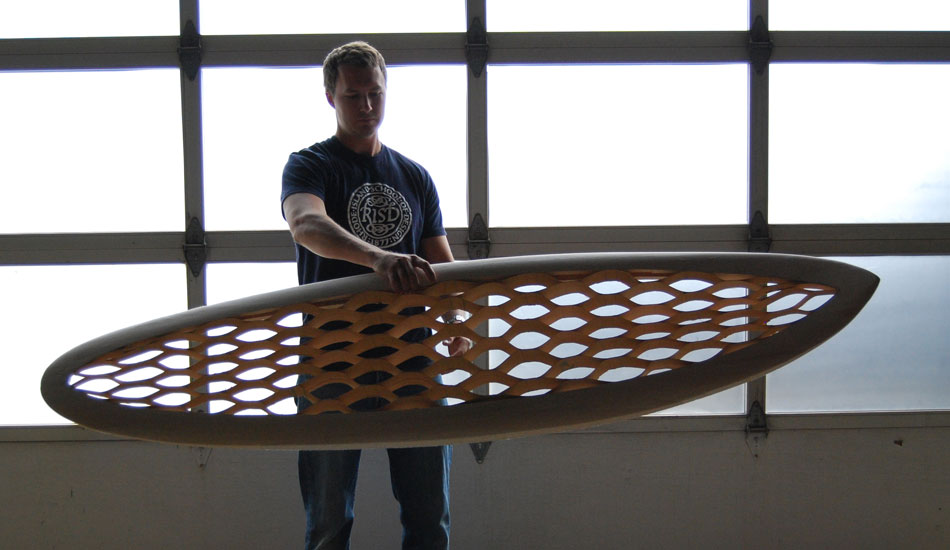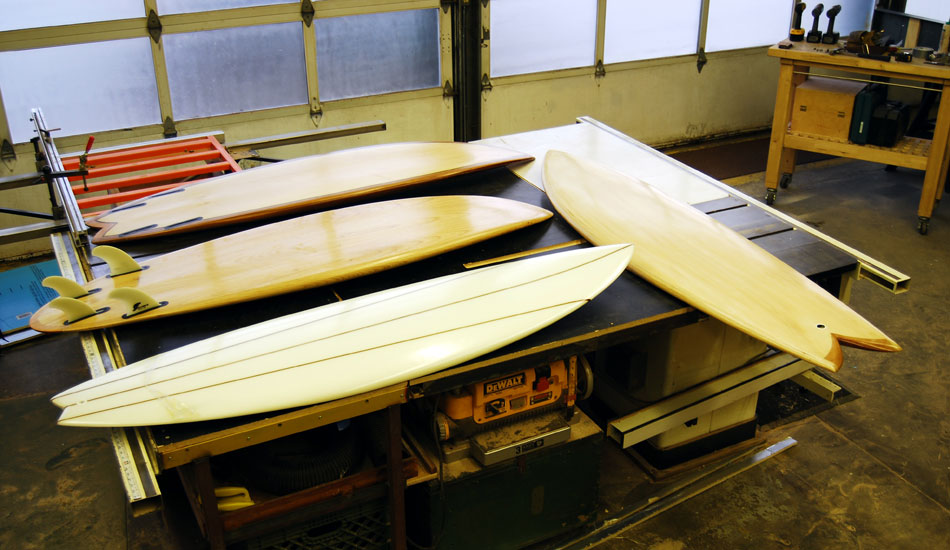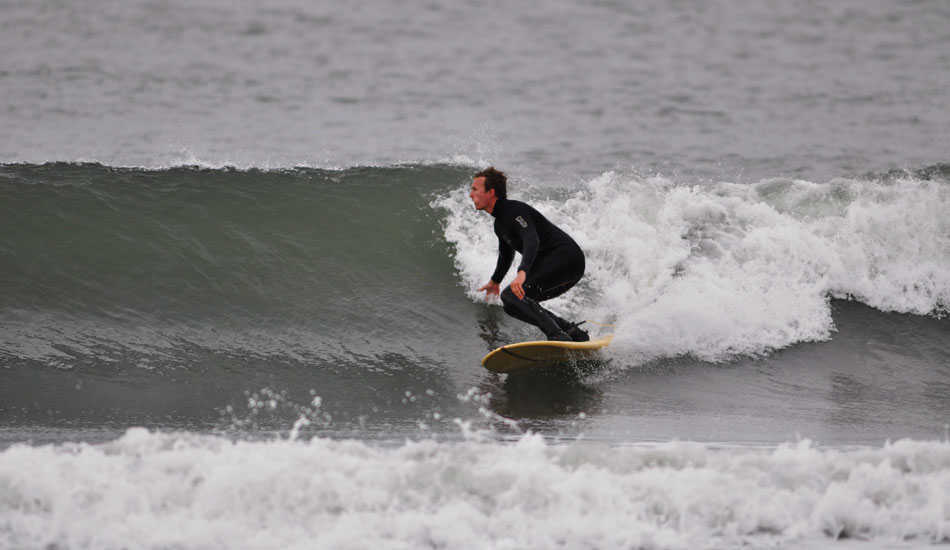
"Wood is natural. It was used in surfboards for a hundreds of years before foam existed. It’s now finally being utilized again for its positive properties in surfboards,” says Kevin Cunningham of Spirare Surfboards. Photo: Joe McGovern
The shaping bay has a garage door that faces the top of Narragansett Bay and is adjacent to an old, heavily used and abused shipyard. Ancient tugs and rusted long liners sit perched on their stands waiting for repair. Oil tanks dot the this old-world part of Rhode Island’s coast and are coupled with rows of vacant brick warehouses and factory buildings that were once sweat-shops for the city’s working class during the Industrial Revolution. These days, the area is being rejuvenated, essentially recycled, by emerging artists and entrepreneurs. The tide is slowly but surely coming back in— the old giving way to the new. But still, it holds the character of an interesting and retro set that you could imagine in a ‘70s era Clint Eastwood flick where the bad guy is being stalked in the fog. It’s a place where a story unfolds. But in this one, it’s a good all around guy, and essentially an idea that’s green and on the move.
Enter Kevin Cunningham. Owner of the fledgling custom surfboard company, Spirare. While Eastwood’s Dirty Harry might offer stink-eye and interrogation, Cunningham shows you around his bay stoked and smiling. He is young and unassuming, with a paddler’s shoulders. He’s at the core, an artist that’s letting inertia take him into the realm where art, design and an environmental responsibility intersect.
Cunningham started out in the basement, experimenting with technique, acquiring planers, routers, sanders and knowledge. The chops of the actual building, the form-making, so to speak, were already there from the sweating it out himself in Rhode Island School of Design’s architecture studios—drawing, making models, and engineering the plans where the form follows the function. He has experience in AutoCAD software that comes in handy as the starting point in plotting the board templates. Templates transfer to Masonite, which serve as basic guides for cutting on a router to create the frames—exoskeletons, of the wood boards. The final shaping, laminating and finishing is done by hand. Fish styles, nose riders, quads, stretch quads, eggs and gunny shapes.
“I do a lot of variations on fish with quad fin setups and what I call post-modern shapes (retro outlines- more full outline with modern foils, rails, and bottom contours),” says Cunningham. “The board shapes a make are pretty standard shapes (shortboard, fish, longboard, etc). The thing that makes me different is how I make them.”
In the beginning, he did the glassing and that process got him thinking about the environmental footprint a surfboard leaves. Questions arose: what if foam could be used that’s greener than the Clark foam that was the industry standard until its plant shut down in 2005? Is it sustainable but feasibly affordable and does it make business sense for the craftsman shaper? What are the alternate materials?
As Cunningham’s shaping experimentation evolved, so did his methods and use of material. He started trying out alternative sources for foam and sourcing David Levy for glasswork
“For the first couple years when I was shaping at RISD, I was ‘self taught,’” says Cunningham. “It wasn’t until I met with Dave (of LSD surfboards) in Narragansett, RI that I really learned how to shape well. Watching Dave shape for a time really showed me everything I was doing wrong and how to do it right.”
“Also, when I started shaping, Grubby Clark was still the dominant blank provider for surfboards,” says Cunningham. “I never liked the toxicity of the standard TDI foam. The first few boards I shaped where done in my living room and I thought there must be a safer material out there.”
Ultimately, the use of wood in my boards came from a desire to shape a completely Green board. I decided wood was the most realistic material for this. I was inspired to go the Green route by an article published in The Surfers Journal in 2003 by Miki Dora.”
All equipment must be ozone friendly and biodegradable. Absolutely no petrochemical products may be used in any of the construction…the ingenuity of the builder is paramount in this venture. Obviously, there are hundreds of possibilities and raw materials available, some thought of and some not. Just to bring to bring to mind a scant few: balsa, the century plant family, veneers, natural glues, tree resins, pitch, tars, fibers, gum, rubber, fabrics, cloths, natural varnishes, wood dowels, chambering, rib construction, non-toxic gas injection, the hemp plants- it’s endless.-Miki Dora

"Wood is natural," says Cunningham. "It was used in surfboards for a hundreds of years before foam existed. It’s now finally being utilized again for its positive properties in surfboards."
So given the choice, what do you prefer to ride? Traditional foam as we know it? Or wood?
Without question. Wood.
Can you elaborate?
Wood flexes. It springs under your feet. It has a glide that’s different than foam. And…it just feels better.
What direction do you see surfing and sustainability moving?
I think shapers need to look for more sustainable materials in surfboard construction. While surfers are traditionally active in the protection of oceans and environments, they have historically (the last 50 years or so) used a product that is highly toxic and creates a large amount of liquid and solid waste; in a foam board with a wooden stringer only 3-4% is renewable material.
Agreed. It’s myopic to think that the ocean, as an environment that we know it, can sustain itself with the way that we are currently interacting with it. From what’s being dumped into it, right down to the materials for the fabrication of what we actually surf on! Just look at the recent discovery of The Great Pacific Garbage Patch. Sooner or later, it all catches up. Which brings us back to the other (natural) material that floats: wood. The basics. You emphasize that lasts longer, has less of an impact, and is grown versus manufactured.
Wood has some amazing characteristics when it comes to surfboards. The flex response of wood is amazing. Wood will flex and bend, then snap back to its original shape far better then foam. Wood also never “tires” like foam; meaning it will flex and snap back over and over again without degrading in quality.
Wood is stronger than foam making and will last ten years and up. Your average short board with heavy use will be ready to replace in two to three.
Tell me a more about the honeycomb structure inside of the boards and how that affects weight, glide balance.
The honeycomb came about as solution to the problem of keeping the weight of a wood board as light as possible while retaining strength.
Using the honeycomb and a balsa perimeter frame I can make my blanks weigh in at just less than 2 lbs for a short board.
Using a perimeter frame in the blank construction puts all the flex in the rails (parabolic rails) giving the boards a more positive response when surfing. You can create more drive coming out of turns with the parabolic rail’s flex response.
How does the process work from conception to production?
The process starts with building a blank. I shape the blanks in the same way I shape foam boards. Thin 1/8” thick wood skins are then applied to the blank on the deck and bottom. The boards are currently receiving a standard poly resin glass job with just one layer of 2 oz fabric on both the deck and bottom.
A lot of trial and error was involved in developing the honeycomb. Each time I tried an idea and it failed it was also a success; now I knew that method didn’t work and I could move on to the next idea.
What’s the main difference in performance? Describe the glide.
The main difference is the drive the boards create when surfing. They take off and really move down the line. The parabolic rails really snap out of turns and create speed.
Beyond technicalities, where does the art and design meet? I noticed some of the stringer detailing is something I haven’t seen outside of a surf museum or a craft show. When I surfed one of your boards locally, I got a few looks, and comments on just how the board looked.
Coming from and art and design background the aesthetics of my boards, foam or wood, is very important to me. I look at surfboards as functional art. I think most surfboards have lost the art and have opted for mass production. Being a hand shaper I want to be able to offer something other than the plain white with company logo single basswood stringer surfboard. My goal is to marry great performance with clean lines and beauty. They also are meant to ride as opposed to being hung on the wall.
Why New England? Given the area’s track record in embracing change and new ideas wouldn’t you have better luck in say, California?
Like most people when they finish school I didn’t really know where I wanted to go. I ended up getting a job for an architect in Connecticut and decided to stay in Providence. I have thought of moving out to California, but now I have established a studio here in RI, it looks like I will be here for a little while longer.”
The waves after all are fluky, cold and not to mention the scene of some provincial attitudes. How does that affect your market when it’s so easy to walk into the local shop or boutique and grab an epoxy off the shelf for much less?
The less-than-ideal wave conditions and weather do make staying in RI hard. Convincing people in New England that my boards are worth the extra cost can be even harder sometimes. Surfers are generally cheap, and they don’t like change. Why try something else when the standard foam board they have trusted for 30 plus years works ok? I do sell more foam boards than wood. Foam is just more approachable to surfers than wood.
I think the big surfboard manufacturers were very successful in convincing surfers that foam is the best product out there. And in some ways it is. Foam is cheap, easy to shape, consistent in quality, and lightweight. But it’s not very environmentally friendly.
Wood is natural. It was used in surfboards for a hundreds of years before foam existed. It’s now finally being utilized again for its positive properties in surfboards.
What’s the hardest thing to accomplish in shaping?
I think the hardest thing for me in shaping is saying a board is done and right. I end up spending more time adjusting little things and going back with a fine grit sandpaper to make sure its as near perfect as possible.
Kevin Cunningham’s work can been seen at Spiraresurfboards.com where he takes custom orders and can point you to retailers.










